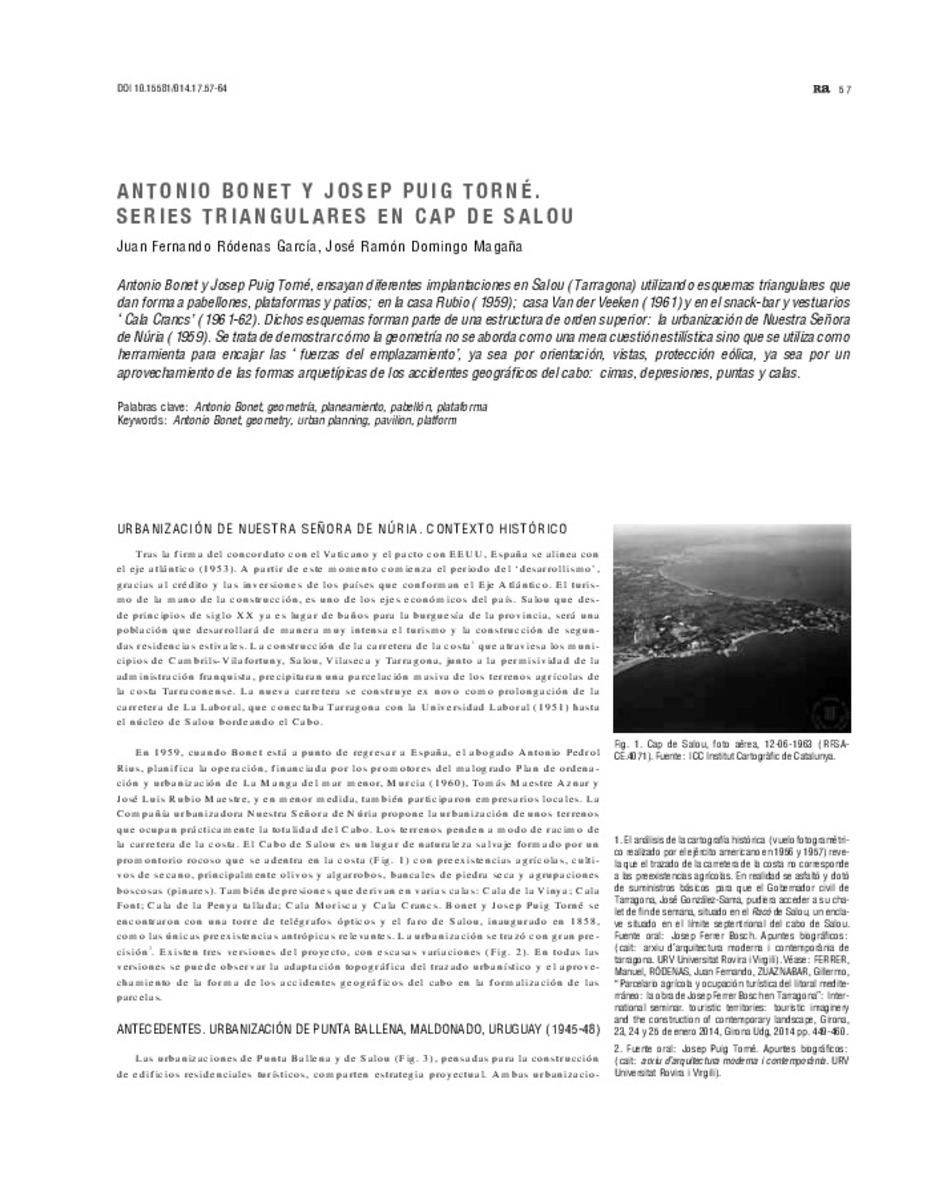Full metadata record
| DC Field | Value | Language |
|---|---|---|
| dc.creator | Ródenas García, F | - |
| dc.date.accessioned | 2016-11-09T10:57:00Z | - |
| dc.date.available | 2016-11-09T10:57:00Z | - |
| dc.date.issued | 2015 | - |
| dc.identifier.citation | Ródenas García, F. (2015). ""Antonio Bonet y Josep Puig Torné. Series triangulares en Cap de Salou"". Revista de Arquitectura, 17, pp.57-64 | es_ES |
| dc.identifier.issn | 1138-5596 | - |
| dc.identifier.uri | https://hdl.handle.net/10171/42165 | - |
| dc.description.abstract | Antonio Bonet y Josep Puig Torné, ensayan diferentes implantaciones en Salou ( Tarragona) utilizando esquemas triangulares que dan forma a pabellones, plataformas y patios; en la casa Rubio ( 1959); casa Van der Veeken ( 1961) y en el snack-bar y vestuarios ‘ Cala Crancs’ ( 1961-62). Dichos esquemas forman parte de una estructura de orden superior: la urbanización de Nuestra Señora de Núria ( 1959). Se trata de demostrar cómo la geometría no se aborda como una mera cuestión estilística sino que se utiliza como herramienta para encajar las ‘ fuerzas del emplazamiento’, ya sea por orientación, vistas, protección eólica, ya sea por un aprovechamiento de las formas arquetípicas de los accidentes geográficos del cabo: cimas, depresiones, puntas y calas. | es_ES |
| dc.description.abstract | Antonio Bonet and Josep Puig Torné tested several possibilities of implementation of tourist residential buildings in Cap Salou ( Tarragona) using triangular patterns such as Rubio house ( 1959), Van der Veeken house ( 1961) and ‘ Cala Crancs’ snack bar and changing rooms ( 1961-1962). Those patterns were part of a higher order structure such as Nuestra Señora de Núria urbanization, designed by Bonet from Argentina in 1959 which derived from Punta Ballena urbanization, Maldonado, Uruguay ( 1945-1948). This document is going to show, through the analysis of Bonet and Puig’s work, that the use of geometry in their projects is not dealt with as a stylistic issue but used as a tool to fit the ‘ site forces’ for the benefit of the projects, whether for aspect, dominant views, wind protection, or harnessing of the landforms of Cape Salou: ridges, depressions, mounds, inlets, amphitheaters, points and coves. In Salou, the archetypal vernacular architectural elements used by Bonet were formalized with triangular patterns: pavilions, platforms and patios. In that sense, Bonet’s attitude in facing his projects can be understood as a research work because he tried not only to solve the particular problems of the commission, but also to achieve his research to go further. He sought a universal solution through the definition of patterns as elements to be improved, perfected, systematized, and as far as possible prefabricated. Patterns were able to mutate and sometimes be transgressed due to several reasons, whether for adapting to a construction system or topographical, climatic or programmatic adaptation. Bonet was an architect who had a clear investigative vocation. This fact was shown in each project when he didn’t use to repeat same constructive solutions but he tried to improve them next time. Researching carries risks but allows hypothesizing and contrasting results. Similarly, Puig Torné was still working in the same way even after the time in which he worked in collaboration with Bonet. | es_ES |
| dc.language.iso | spa | es_ES |
| dc.publisher | Servicio de Publicaciones de la Universidad de Navarra | es_ES |
| dc.rights | info:eu-repo/semantics/openAccess | es_ES |
| dc.subject | Plataforma | es_ES |
| dc.subject | Pabellón | es_ES |
| dc.subject | Geometría | es_ES |
| dc.subject | Antonio Bonet | es_ES |
| dc.subject | Planeamiento | es_ES |
| dc.title | Antonio Bonet y Josep Puig Torné. Series triangulares en Cap de Salou | es_ES |
| dc.title.alternative | Antonio Bonet and Josep Puig Torné. Triangular Patterns in Cap de Salou | es_ES |
| dc.type | info:eu-repo/semantics/article | es_ES |
| dc.identifier.doi | 10.15581/014.17.57-64 | es_ES |
Files in This Item:
Statistics and impact
Items in Dadun are protected by copyright, with all rights reserved, unless otherwise indicated.






